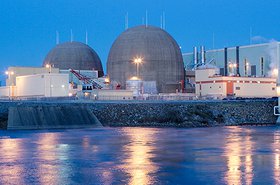CyrusOne has issued a sustainability report which details its efforts to counter its Scope 1 and 2 carbon emissions - and includes commitments on becoming water positive.
The data center operator says its four European data centers now use 100 percent renewable energy and have offset the small amount of diesel they burn in backup generators, thus meeting its commitment under the European Climate Neutral Data Centre Pact nine years before the 2030 deadline.
Worldwide, the detailed report says that 13 percent of the electricity consumed by the company is from renewable sources, an increase from 2020's figure of around two percent. In 2021, the company consumes bought some 420,000MWh of renewable electricity, and more than 2,800,000MWh of non-renewable electricity
The company has an average power usage effectiveness (PUE) of 1.48.
Power play
In 2021, CyrusOne increased its renewable energy purchases seven-fold, going from 59,000MWh to 420,000MWh. For preference, the company buys through power purchase agreements (PPAs) which add renewable capacity locally. As alternatives, it also buys some virtual PPAs, but is proud of not buying unbundled RECs, which have been criticized by green groups. The company also signed contracts for future delivery of an additional 107MWh/year of renewable power in future.
The company reported total Scope 1 and Scope 2 emissions (the emissions the company produced directly, and indirectly through its use of electricity) of more than one million megatons of CO2 equivalent per year. There is some variability in that figure depending on whether a "location-based" or "market-based" methodology is used.
CyrusOne also reported Scope 3 emissions (from its supply chain including suppliers and buildings it constructed) of 255,000 megatons of CO2 equivalent in 2021. This is about one-quarter of its Scope 1 and Scope 2 emissions - for comparison, Microsoft's Scope 3 emissions dwarf its Scope 1 and Scope 2 emissions. CyrusOne did not complete any building projects in 2021, and it includes customer-owned servers within its Scope 2 emissions.
Water use
In the area of water use, CyrusOne says it is progressing towards becoming water positive, and has a strategy of moving away from the use of evaporative cooling to systems which don't use up water - and challenges a normal industry assumption, that evaporative cooling saves total water because it saves energy and reduces water-intensive electricity generation.
Three of its facilities (Chandler, Arizona; Carrollton, Texas; and Allen, Texas) as well the company headquarters are now net water positive, and the company is increasing the proportion of what it calls "dry" facilities, which don't use evaporative cooling.
"Traditionally, data centers have utilized cooling systems that evaporate water, removing millions of gallons of water from the watershed and discharging wastewater with highly concentrated contaminants to the local treatment system," says the ESG report. "Avoiding evaporative cooling results in a somewhat higher design PUE (power usage effectiveness) than could be achieved by 'burning' water instead of electricity, but it allows us to prepare for the future and mitigate the impacts data centers have on regional water supplies."
Often data center operators point out that electricity generation uses water, so doing away with evaporative cooling will increase water use upstream because it increases electricity use. CyrusOne says it has done the math, and evaporative cooling is something to do away with, despite this consideration.
"We understand that no matter how much we reduce our onsite water consumption, as long as we are reliant on grid electricity, we are indirectly responsible for the consumption of large amounts of water through traditional thermoelectric electrical generation for the foreseeable future," the ESG report says. "We have begun efforts to quantify this energy supply chain water consumption.
"The water consumed in electricity production, sometimes referred to as the 'embodied water of electricity' or 'virtual water,' is often used to justify employing less expensive evaporative cooling to save electricity. The rationale is that water expended onsite is simply replacing water that would have been used in electrical generation and that it all evens out in the end. There is some truth in this hunch, especially when the electricity consumed comes from thermoelectric sources (like fossil fuel or nuclear generation). However, we know that solar and wind generation consume negligible amounts of water. As both electrical grids and individual consumers like CyrusOne replace thermoelectric sources with wind and solar generation, the water embodied in the electricity we consume decreases dramatically. When we reach our net-zero carbon target through the use of renewable energy, we will consume effectively no water for cooling at the vast majority of our facilities, whether directly through water-consuming cooling or indirectly through our electricity use."




